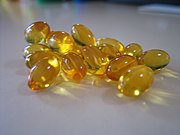
The Ancient Egyptians knew that feeding a patient liver (back, right) would help cure night blindness.[1]
Vitamins are chemical compounds that are necessary for human life. Most vitamins are found in the food we ingest, as the human body is unable to produce vitamins on its own.[2] There are several known vitamins. These are usually divided into two sub-groups:
- Lipofile vitamins may be stored in fatty tissue, so that it may be called upon by the body in times of scarce supply; thus, shortage is rare, whilst overdose is possible through prolonged excessive intake.[2]
- Hydrofile vitamins cannot be stored in the body, and excess amounts are quickly eliminated from the body. With the exception of vitamins B3 and B6, the risk over overdose is minimal, whilst the risk of insufficient intake is somewhat serious, occurring in as little time as a few weeks to months.[2]
- Vitamin B, which actually comprises a compound of different vitamins with effects on many things, from metabolism to counteracting nerve damage.
- Vitamin C, a powerful antioxidant - especially in collaboration with Vitamin E. Was among the first vitamins discovered, and was used by the navy as a measure against scurvy.
Apart from these, researchers have found several thousand phytonutrients that appear to play an equally vital role in human metabolism.
History[]
One of the first records mentioning vitamins is a recommendation from 1611 stating that lemon juice was an efficient remedy for scurvy. A study corroborated this fact in 1757, but it still took a while for this to become common knowledge; as late as 1875, scurvy was still a fairly common disease aboard ships of the British Navy.[2]
Early in the 20th century researchers realised that food was more than simply a source of energy; other substances must be present in the food, nutrients that the body required. Further research linked this with diseases like scurvy, rickets, beriberi and pellagra. In the mid-1900's supplements were introduced as treatments for these ailments, and though sometimes accused of having no effect, or even of being hazardous to health, the use of supplementation has become ever more wide spread since.[2]
The need for supplementation has been aggravated since the late 1900's as fields have beome increasingly subjected to inorganic fertilization and herbicides, which have depleted the nutrient content of the food grown in such fields. The organic food industry is on the rise as a result of this, but pricing and resistance from the traditional food industry often make it difficult for these products to compete.[2]
Supplementation[]

Cod liver fish oil, a supplement rich in vitamin A, packed in capsules.
Supplementation is the practice of introducing supplementary nutrients to the body, often in the form of tablets or vitamin rich infusions. Studies show that many people are not eating an adequate, varied diet and thus are nutrient deficient.[2] Supplements aim to supply the body with the nutrients it requires to function optimally. It is worth noting, however, that supplement should be taken alongside a meal. The main reason for this is that supplements should never be considered substitutes for a balanced diet. Secondly, a meal will ensure an adequate suppply of both water and fat, allowing the body to absorb both hydrofile and lipofile vitamins. And thirdly, after ingesting a meal the blood flow to the stomach is increased, again allowing better absorption of the nutrients in both food and supplements.[3]
Effects of supplementation[]
The renowned english medical journal The Lancet published a study in 1988 showing increased learning capacity in scandinavian children through use of supplementation. Likewise, other studies from North America show a decrease in repeated crininal activity on juvenile delinquents given supplementation while incarcerated.[2]
In the 1950's the american researcher Denham Harman described how antioxidants could protect against the signs of ageing, if doses of 10-300 times the recommended value were administered.[4] These same processes also play major roles in many of the ailments that are found in the developed countries - among these atherosclerosis, cancer, arthritis, senile dementia and Parkinsson's disease.[2]
References[]
- ↑ "Proceedings of the 13h Annual History of Medicine Days", a medical historical paper from University of Calgary. March 2004.
- ↑ 2.0 2.1 2.2 2.3 2.4 2.5 2.6 2.7 2.8 Flytlie, K.T. (2007) (in danish). Vitaminer og mineraler (1st ed.). People'sPress. p. 11-17. ISBN 978-87-91293-97-9. http://www.vitamindoktor.com.
- ↑ Askew, G. & Paquette, J. (2007) (in english). Secrets of Supplements (1st ed.). PhyteMedia. p. 137. ISBN 978-0-9784290-0-3. http://www.phytemedia.com.
- ↑ Harman D. (1992) (in english). Vitamins Beyond Deficiency. New York Academy of Science.
| Wikimedia Commons has media related to: vitamins |